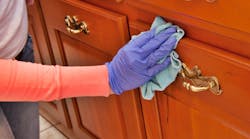How clean is your dental office? 5 tips to keep your patients healthy and happy
As dental assistants, patient health and safety is our No. 1 priority. Everything we do during our busy day revolves around keeping patients safe. But what if there was more we could be doing? What if we're missing a detail that could cost us a happy patient?
We're going to take a look at five tips that everyone in the dental industry should implement in their office. If these tips are already a part of your team's daily routine, give yourself a pat on the back! You're on the right track for keeping patients happy and healthy.
RELATED: State-of-the-art dental practice, state-of-the-art infection control?
Keep your sterilization procedures up to date with OSHA and CDC guidelines
Seems pretty simple and straightforward, right? It should be. However, I’ve seen dental practices still clinging to outdated sterilization procedures. The sterile area is your responsibility as a dental assistant. What you do in sterile could potentially harm a patient if your office is not changing with the times.
You need a "dirty" side and a "clean" side. The two should not mix. Label the areas with visible labels to help remind yourself and others. Instruments, cassettes, and other equipment should be wrapped or placed in self-sealing packages before being placed into the autoclave or statim. Be sure to date the outside of packages before placing them in the autoclave.
There is no shame in making a step-by-step list to help you remember the appropriate procedures in the sterile area. I've noticed the smoothest running offices seem to be the ones with lists and labels everywhere. Not only does it help the team perform as a cohesive unit, it helps newcomers out as well.
Cross contamination should be a thing of the past
Have you seen a fellow teammate touch a patient chart or the inside of a drawer with gloves on? Have you ever been in a rush to turn over an operatory and possibly missed wiping a surface? We're all human, and we all make mistakes. However, those mistakes should be few and far between and should not involve cross contamination.
Hepatitis B can stay alive on hard surfaces for 16 hours. It is easy to catch and can kill just as easily. As health professionals, we should protect ourselves with the Hepatitis B vaccine, but our patients might not do the same thing. It is our job to protect our patients.
The entire operatory must be adequately sprayed with CaviCide and wiped with CaviWipes or similar brands. Make sure to wipe under barriers. Patient chairs must be wiped from head to toe regardless of how expensive the leather is. Wipe X-ray sensors from end to end. Wipe drawer handles and X-ray switches thoroughly. These steps may sound redundant, but we have all seen little things like these be overlooked.
Pretend like your next patient is a loved one. Would you want your child or mother sitting in an operatory that may not be as clean as it should be?
It is not acceptable to have dust around the office
If there is dust clinging to shelves in the operatory or sitting in a corner of a sterile counter, you can bet bacteria and aerosol particles are mixed with it. If you spot a bit of dust, quickly wipe it up with a CaviWipe. There is no need to go on a hunt around your office for spare dust. Make wiping up dust a part of your routine. If you see it, don't leave it! Clean it up.
Restrooms need to be kept in check
These days, most offices have a cleaning service. You may not be refilling paper towels and scrubbing toilets, but you should be keeping germs in check. A member of your team should be cleaning door handles, faucets, and knobs during the morning routine. Lysol spray or CaviWipes work nicely to keep germs at bay.
Keep the front desk and reception area clutter-free
This tip has to do with patient happiness more than health, but it is no less important. The reception area is a patient’s first impression of the entire office, and first impressions stick. What are patients going to think if there are post-it notes and charts scattered all over the front desk? What will patients think if magazines are scattered in the reception area? It doesn't look professional and it doesn't project a good first impression.
Having a clutter-free reception area does not mean it has to be sterile and cold. It is possible to achieve a comfortable feeling in the reception area while still being tidy. Give your patients the first impression they expect.
Keeping patients happy and healthy is a team effort. Try to get your team on board when making positive changes. Putting a list together could be a fun group exercise and a great first step in the changes your office may need to take to keep patients happy and healthy.
-----------------------------------------------------------
MORE READING
Are we clean yet? A look at endodontic instrumentation
Preparing for the unannounced OSHA inspection
-----------------------------------------------------------
Ashley Pero lives in Portland, OR. She has most recently been working for Dental Staffing Inc. while on maternity leave. She enjoys reading, writing, and learning about new things in dentistry.





